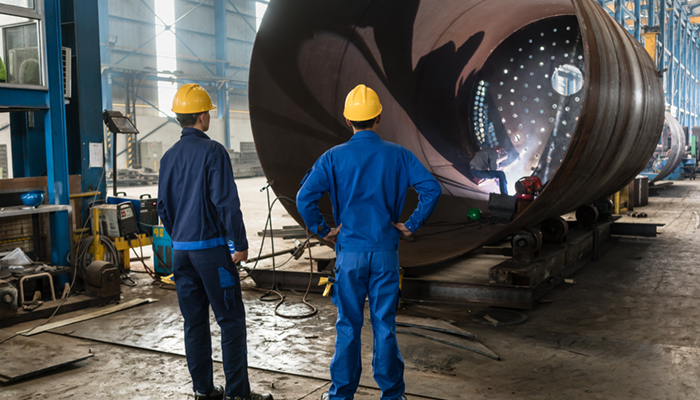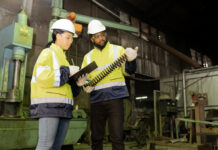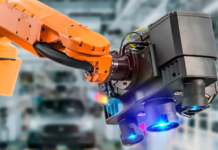 For manufacturers, securing talent is an increasing challenge. Many companies (over 80%) say there aren’t enough trained, skilled workers to fill the current openings they have. Unless things change, it is projected that 2 million jobs will go unfilled over the next 5 years. Universities and colleges are working to fill the need, but recruiting and retaining employees, especially millennials, has proved to be a huge issue.
For manufacturers, securing talent is an increasing challenge. Many companies (over 80%) say there aren’t enough trained, skilled workers to fill the current openings they have. Unless things change, it is projected that 2 million jobs will go unfilled over the next 5 years. Universities and colleges are working to fill the need, but recruiting and retaining employees, especially millennials, has proved to be a huge issue.
This challenge can’t simply be remedied by training and building a larger workforce. Manufacturing has to compete with other industries for talent, and often has to contend with disadvantages including an antiquated brand image, locations in remote and low-populated areas, and outdated operational infrastructures, just to name a few.
The Talent Threat will hinder the growth and advancement of the manufacturing industry as a whole, and it will require every manufacturer and manufacturing organization to work together to overcome this challenge. While we all are seeking a silver bullet solution, the reality is there’s no simple fix.
There are 4 critical components to the Talent Threat, each of which need to be addressed in tandem to overcome the looming resource gap:
The Brand of Manufacturing
Manufacturing gets a bad rap. For every big-name company, from GE to Polaris, which has advanced and enhanced their individual brands to more effectively recruit talent, there are hundreds of mid-market manufacturers that still reflect and live the manufacturing “brand” of the 1940’s, 1950’s, and 1960’s. When an organization is seeking young, eager, and fresh talent, money isn’t the only motivator. If your internal operations are still driven primarily by paper, or your facility looks like you stepped right out of the 1970’s, or your employees are working in dark, dirty, unkept environments, it doesn’t scream “there’s career potential here!”.
The image of manufacturing can only be changed by breaking the existing stereotypes, starting with facilities themselves, all the way to a broader national message on the variety of roles, opportunities, and careers available. While we still need welders and CNC operators, manufacturers also need accountants, marketers, salespersons, purchasers, and more. The manufacturing brand message and image needs to reflect that diversity, starting with your own business.
The Use (or Lack There Of) Technology
Too many manufacturers are still stuck in the past from a technology perspective. Managing customer data on paper or Excel spreadsheets. Receiving PO’s by fax. Accessing sales and order information through a blue-screen terminal. All of these technologies existed prior to millennials even being on this earth. When you’ve grown up with Google, what’s the value in learning a 20-year old computer system? How is that skill transportable? How does that knowledge provide opportunity for advancement, or help increase my value to the company?
The lack of enhanced technology doesn’t only increase the challenge of talent recruitment, but it also limits the organization’s growth as a whole. If your organization hasn’t kept up with new ways to do business better and operate more efficiently and effectively, it sends the message that you might not even be in business much longer. A prospective employee can see and understand that risk.
The Status-Quo Internal Culture
Every industry has its internal culture challenges, but the manufacturing industry is unique. Many mid-sized manufacturers are located in more remote, less-densely populated parts of the country. Talent access is typically limited to a 100 mile radius. These close-knit organizations often employ almost entire towns, with friends, family, and relatives all working within the same facility. And with this often comes an insular perspective. Major change is infrequent.
A “this is the way we do things around here” motto is prevalent. While it’s fantastic to have a loyal workforce with a strong work ethic, new employees with varying backgrounds, experiences, and perspectives can have a hard time fitting in. New ideas brought to the table can be faced with strong resistance. If organizational leadership is tied to maintaining a “status quo” culture, new talent will churn in-and-out of the organization at a high cost to the company.
By nature, most people seek roles that are challenging, that generate a sense of pride and accomplishment, which create value and give them purpose. If your organization is mired in “the old way”, and are simply struggling to find someone that will commute 45 minutes for mid-level pay, do a task without “making waves or asking any questions”, leave and return day after day, you’ll continue to struggle finding value-added talent.
Resistance to Continuous Improvement and Change
“If it’s not broke, don’t fix it”. It’s a frequent mantra for mid-market manufacturers. With pressures to increase sales and profits, with a lean staff and little capital, it’s no wonder that there’s even less time to address process improvements or modernize operations. But the gold-rush days of profitability, growing year-over-year from only 2 or 3 key customers, are quickly dying. Manufacturers need to start finding new ways to compete, generating more sales from a more diverse customer and industry base.
Without building and sustaining a culture of continuous improvement and change, how can you effectively reach this goal? Most OEMs are now requiring direct, electronic connections to their purchasing systems, ISO certification, and more value-added services from their vendor-partners than simply order fulfillment. If your organization isn’t keeping up with these new market demands, you’ll be hard pressed to compete with the supplier down the street who does.
New talent can provide the necessary skills, background, and experience to help implement change, but they can’t do it alone. Many eager new hires will start with the best of intentions, only to find it takes a team to turn the ship. Organizational leadership must set the tone for how change is embraced, and follow through with consistent action, or lose that talent to a company who does.
While the Talent Threat is real, manufacturers can’t rest on their laurels and hope that regional educational institutions will simply pump out more skilled tradesmen. Even though it’s an essential aspect to filling the skills gap, companies themselves must step up to the plate in making their businesses and organizations more candidate-friendly.
The last two generations have seen their parents and grandparents work for manufacturers that moved operations overseas, laying off 20-year veterans to the company, or shutting their doors completely. We have to now, more than ever, rebuild the trust between employees and employers in manufacturing.
We need to prove that manufacturing isn’t stuck in the dark ages. We need to show there’s career potential beyond the stereotypical roles. We need to let people know that a job in manufacturing isn’t second class. But this will only resonate when manufacturers make that message a reality, and not simply a marketing campaign.





















